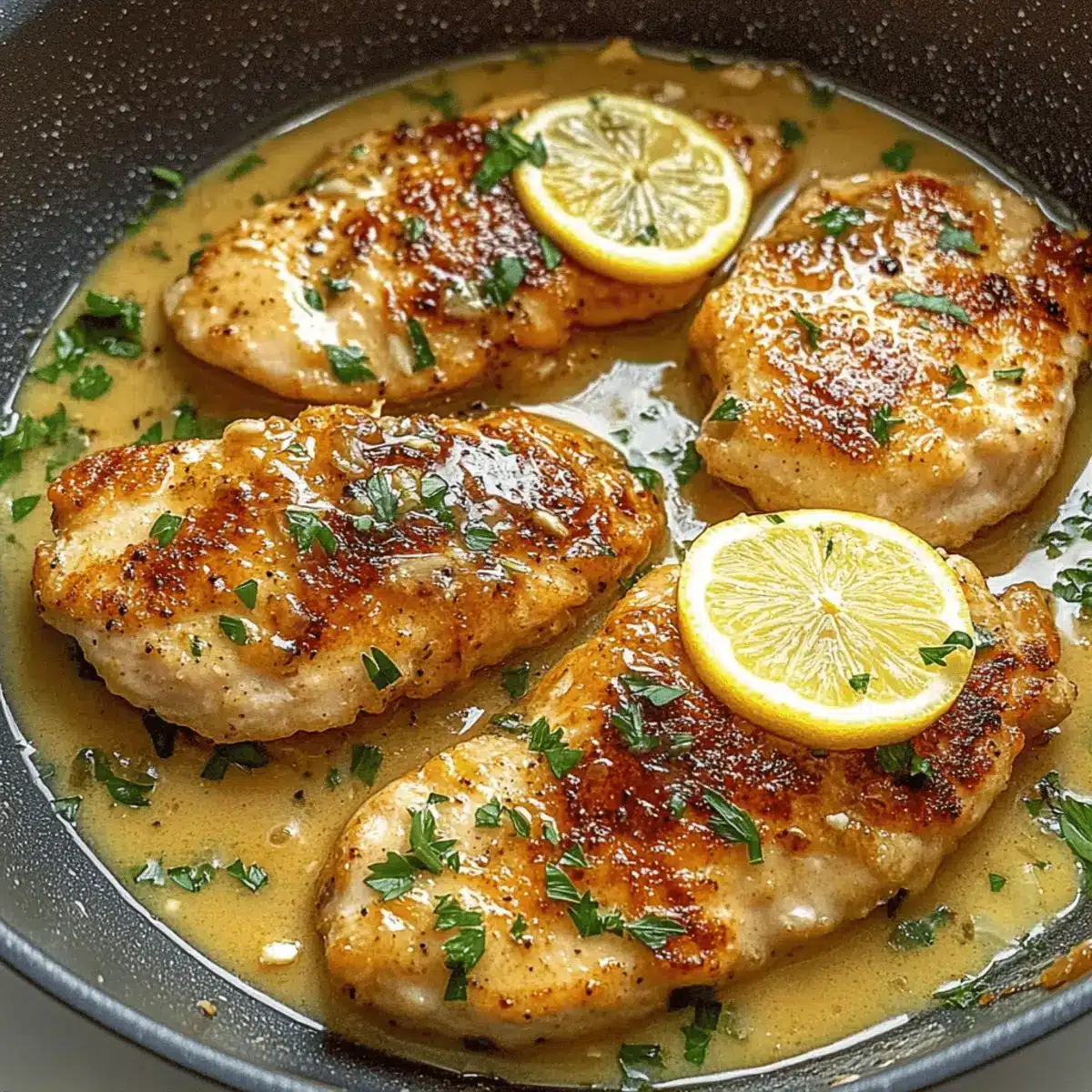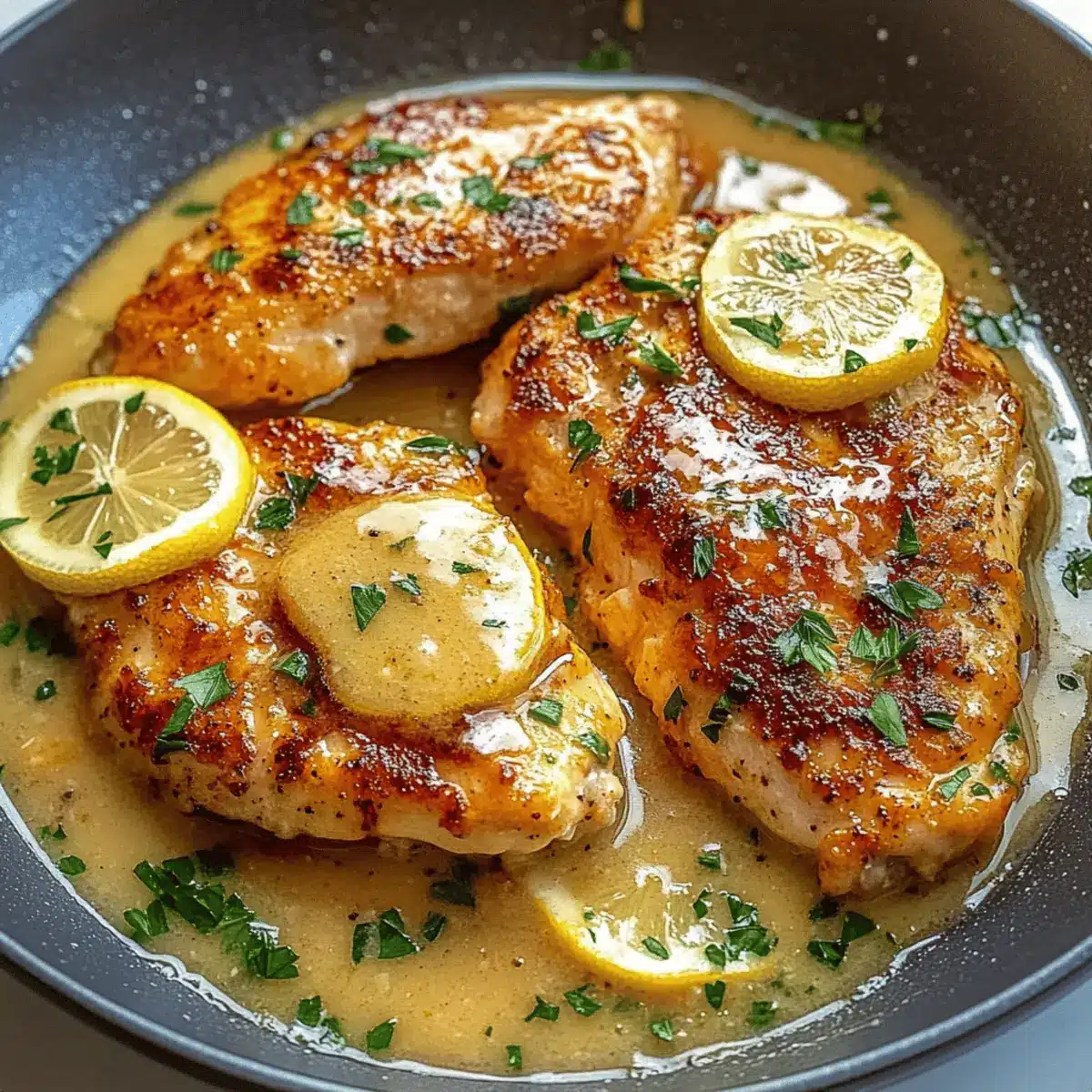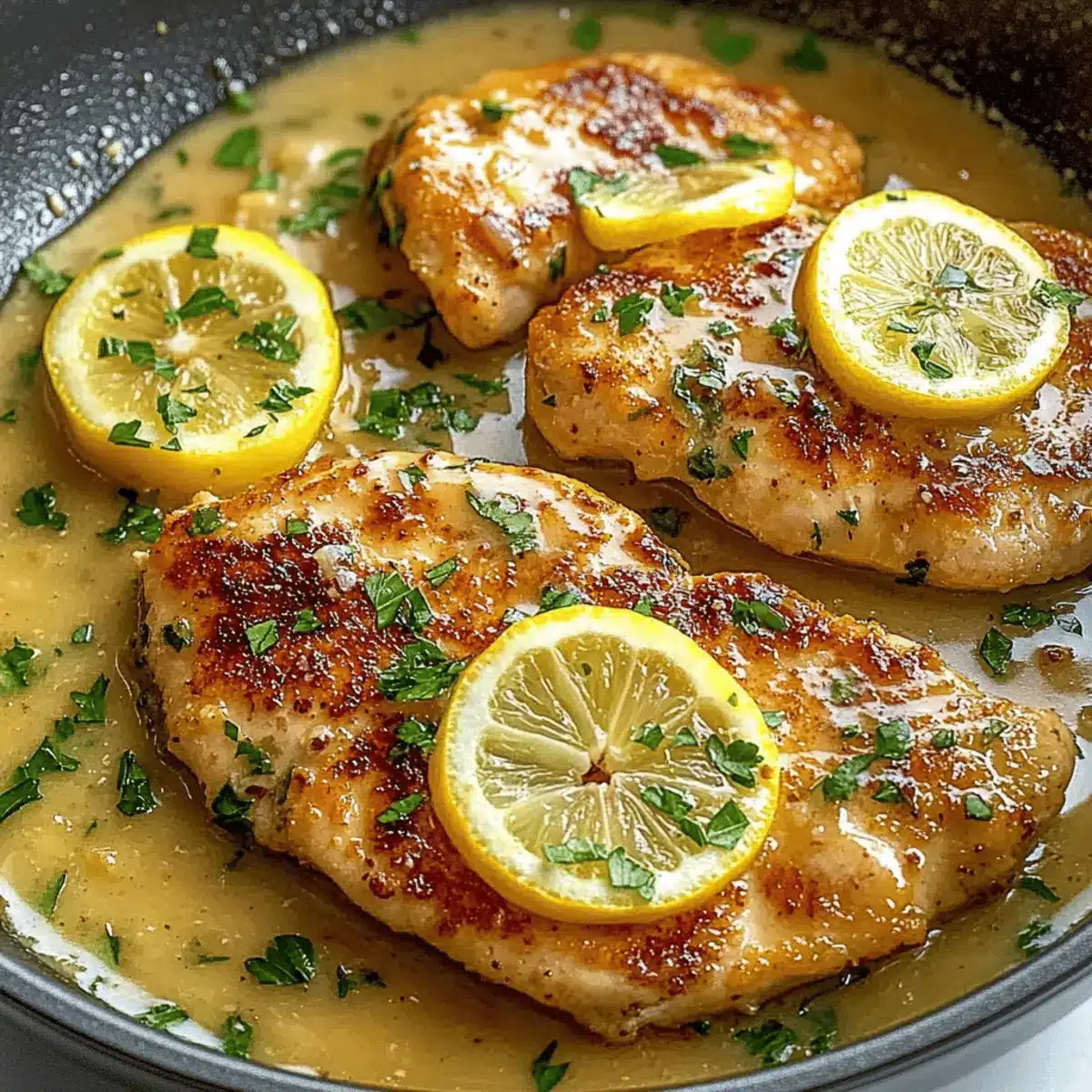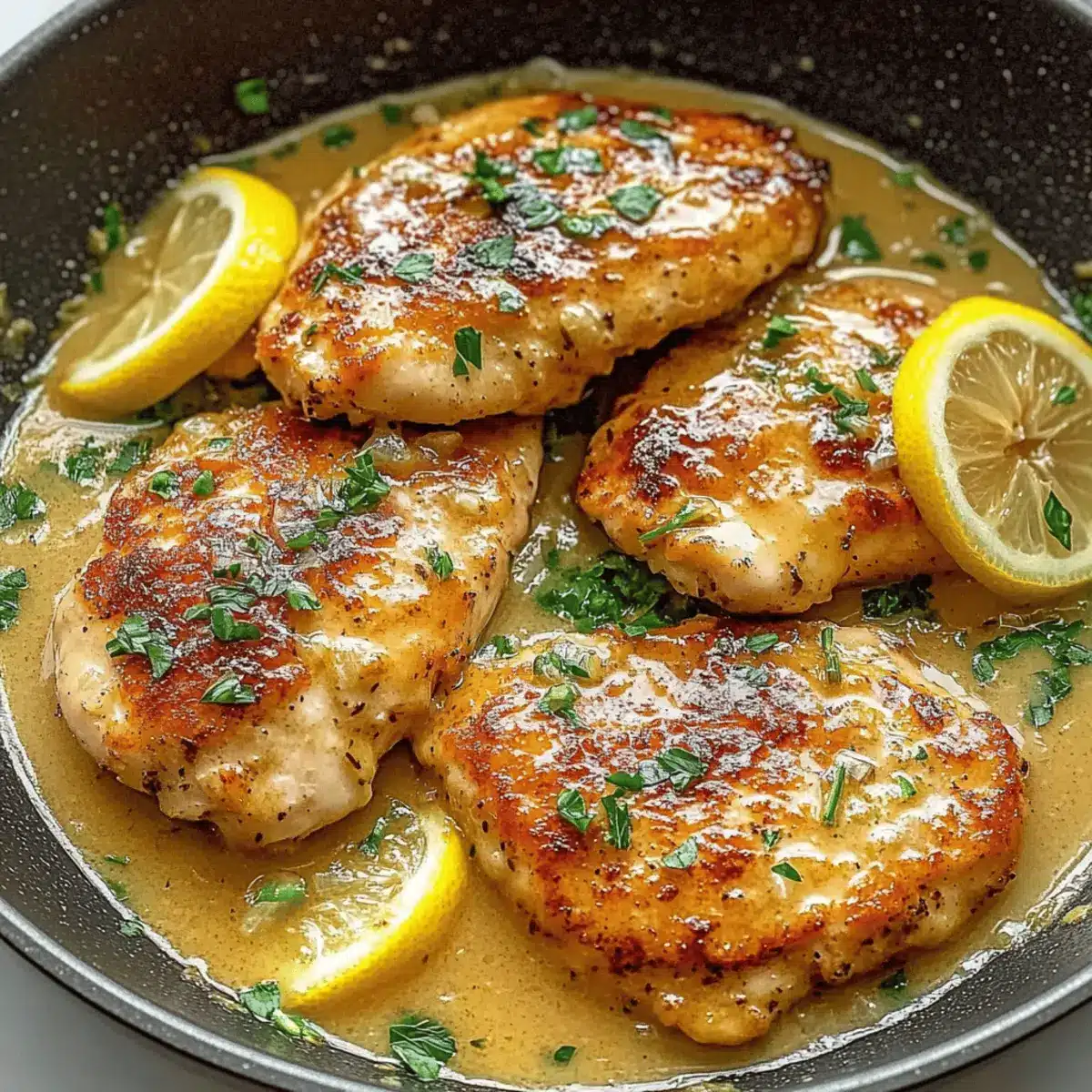As I flipped through my favorite cookbook, an enticing aroma of lemon and herbs soon wafted through the kitchen, reminding me of the magic in homemade meals. One dish that never fails to impress is Chicken Francese, an iconic Italian-American recipe featuring tender chicken cutlets bathed in a zesty lemon butter sauce. Perfect for both hurried weeknights and laid-back Sunday dinners, this easy-to-make dish isn’t just a time-saver; it’s also a sure crowd-pleaser that elevates your culinary game in minutes. Whether you serve it with a side of pasta or roasted veggies, you’ll find that the combination of crispy chicken and a tangy sauce creates a comforting yet sophisticated dinner option. Curious about how to whip up this delightful meal? Let’s dive into the recipe!

Why is Chicken Francese a must-try?
Simplicity at Its Best: This recipe is incredibly easy to follow, making it perfect for both novice cooks and seasoned chefs alike.
Bold, Bright Flavors: The zesty lemon butter sauce brings a refreshing contrast to the juicy chicken, creating a flavor explosion with every bite.
Quick Cooking Time: Ready in just 30 minutes, Chicken Francese is ideal for those busy weeknights when you want something delicious without the hassle.
Versatile Pairing Options: Whether you pair it with pasta, risotto, or a fresh salad, this dish adapts beautifully to suit any meal.
Crowd-Pleasing Elegance: Impress guests with this restaurant-quality dish that’s guaranteed to become a favorite, just like my other hits like Chopped Chicken Caesar Wrap or Greek Chicken Meatballs.
Enjoy the delightful journey of homemade comfort food!
Chicken Francese Ingredients
• Get ready for a flavorful adventure with Chicken Francese!
For the Chicken
- Boneless, Skinless Chicken Breasts – The star of the dish; slice them in half for quick cooking.
- Flour – A light coating helps achieve that perfect golden crust during frying.
For the Sauce
- Fresh Lemon Slices – Adds a burst of acidity and brightness to your Chicken Francese.
- Chicken Broth – Deepens the flavor of the sauce; opt for vegetable broth if you prefer a lighter taste.
- Dry White Wine – Enhances flavor complexity; feel free to replace it with additional broth to keep it alcohol-free.
For Cooking
- Butter – This contributes rich creaminess to the sauce; unsalted butter is recommended for better salt control.
- Olive Oil – Combines with butter for frying and prevents burning while adding extra flavor.
For Garnish
- Chopped Parsley – A fresh touch to brighten up your dish; basil or cilantro can also be used for a unique twist.
Dive into making one of the most satisfying comfort foods—Chicken Francese!
Step‑by‑Step Instructions for Chicken Francese
Step 1: Prepare the Chicken
Begin by placing your boneless, skinless chicken breasts on a cutting board. Using a sharp knife, slice each breast in half horizontally to create thinner cutlets. Pat them dry with paper towels to ensure they are moisture-free, which helps the flour adhere better. This simple preparation gets your Chicken Francese off to the right start!
Step 2: Dredge in Flour
On a large plate, spread out a generous layer of flour. Take each chicken cutlet and gently coat it in flour, shaking off any excess. This light covering will give your chicken that coveted golden crust when fried. Set the floured chicken aside while you heat your skillet, leaving space for your cooking area to stay organized.
Step 3: Fry the Chicken
In a large skillet, heat 2 tablespoons of unsalted butter and 2 tablespoons of olive oil over medium-high heat. Once the butter is melted and bubbling, carefully add the chicken cutlets to the skillet without crowding. Cook them for about 3-4 minutes per side, until they are golden brown and cooked through. Once perfectly browned, remove the chicken and transfer it to a plate to rest.
Step 4: Make the Sauce
In the same skillet, reduce the heat to medium and add 1 cup of chicken broth, 1/2 cup of dry white wine, and several fresh lemon slices. Use a wooden spoon to scrape up the flavorful brown bits from the bottom of the skillet, infusing your sauce with those tasty remnants. Bring the mixture to a gentle simmer, allowing the flavors to meld together beautifully for about 2-3 minutes.
Step 5: Thicken the Sauce
Let the sauce simmer for another 3-4 minutes until it reduces slightly and thickens. Keep a close eye on it; you want it to become a luscious and vibrant sauce. After thickening, return the cooked chicken to the skillet, spooning some sauce over the top. Allow the chicken to heat through for 2 minutes, ensuring it is perfectly integrated into the flavors of the Chicken Francese.
Step 6: Garnish and Serve
Once everything is warm and beautifully combined, take your Chicken Francese off the heat. Sprinkle freshly chopped parsley over the dish for a pop of color and freshness. Serve hot, alongside pasta, rice, or roasted vegetables for a delightful meal. This vibrant presentation will surely impress anyone at your table!

What to Serve with Chicken Francese
Elevate your meal experience with vibrant sides that balance the zesty flavors of this classic dish.
- Creamy Mashed Potatoes: Their smooth texture and richness provide a comforting contrast to the light lemon sauce and add warmth to your dinner table.
- Garlicky Green Beans: The bright crunch of sautéed green beans seasoned with garlic adds color and fresh flavor, making every bite delightful.
- Lemon Herb Rice: Fluffy rice infused with lemon and herbs mirrors the dish’s tangy notes, creating a harmonious and satisfying pairing.
- Roasted Vegetables: A medley of seasonal vegetables, roasted until caramelized, delivers earthy depth that complements the chicken’s brightness perfectly.
- Caesar Salad: Crisp romaine topped with creamy dressing and crunchy croutons offers a refreshing bite that contrasts beautifully with the tender chicken.
- Bruschetta: This classic Italian starter features toasted bread topped with diced tomatoes, basil, and balsamic glaze, setting the stage for your meal with a burst of flavor.
- Chardonnay or Pinot Grigio: A glass of chilled white wine, like Chardonnay or Pinot Grigio, enhances the zesty notes of the chicken while making you feel like you’re dining out.
- Lemon Sorbet: To finish on a refreshing note, serve lemon sorbet for a light and zesty dessert that echoes the main dish’s flavors and cleanses the palate.
Make Ahead Options
Preparing Chicken Francese in advance is a fantastic way to save time on busy weeknights! You can bread the chicken cutlets and refrigerate them for up to 24 hours before cooking to lock in freshness. Additionally, prepare the lemon butter sauce ahead and store it separately in the refrigerator for up to 3 days; just be sure to cool it completely before sealing in an airtight container. When you’re ready to serve, simply reheat the sauce gently on the stove while cooking the chicken—don’t forget to spoon that delicious sauce over once the chicken is cooked. This way, you’ll enjoy the same delightful flavors without the last-minute rush!
Chicken Francese Variations & Substitutions
Feel free to get creative with this Chicken Francese recipe and tailor it to your taste preferences!
-
Dairy-Free: Use olive oil instead of butter to create a lighter sauce that maintains the dish’s zest.
-
Vegetarian Delight: Swap chicken for eggplant slices; coat and fry them for a delicious meat-free alternative.
-
Spicy Kick: Incorporate a pinch of red pepper flakes into the sauce for that perfect fiery twist.
-
Herb Variations: Try using fresh thyme or rosemary instead of parsley for a wonderful aromatic depth.
-
Pasta Swap: Serve with zucchini noodles instead of traditional pasta for a low-carb twist that adds great flavor.
-
Different Citrus: Substitute lime for lemon to introduce a unique citrusy zing that brightens the sauce in a surprising way.
-
Broth Alternatives: If avoiding chicken broth, vegetable broth works beautifully and enhances the flavor without compromising richness.
-
Wine-Free Sauce: Replace dry white wine with additional chicken broth and a splash of apple cider vinegar for acidity without the alcohol.
Feel inspired by these variations, and remember, if you enjoyed this dish, you might also love trying my Sticky Garlic Chicken Noodles or the fresh flavors of Fried Chicken Street Corn Tacos!
Expert Tips for Chicken Francese
-
Prep Pointers: Make sure to pat the chicken dry before dredging; moisture will hinder the flour from adhering well.
-
Cook with Care: Avoid overcooking the chicken; it should reach 165°F (75°C) but remain juicy and tender for the best Chicken Francese experience.
-
Sauce Secrets: For depth, simmer the sauce longer to allow flavors to intensify. It’s a crucial step that makes a world of difference!
-
Keep It Crisp: Fry in batches if needed. Crowding the skillet can lower the temperature, resulting in soggy chicken instead of that perfect golden crust.
-
Garnish Wisely: Don’t skip the chopped parsley! It not only adds flavor but also brightens up the final presentation, making your Chicken Francese visually appealing.
How to Store and Freeze Chicken Francese
Fridge: Store leftovers in an airtight container in the refrigerator for up to 2 days. This keeps the Chicken Francese fresh and ready for quick meals.
Freezer: If you want to extend the life of your Chicken Francese, freeze it in a well-sealed container for up to 3 months. When ready to eat, thaw overnight in the fridge before reheating.
Reheating: To reheat, warm the chicken in a skillet over low heat with a splash of chicken broth to help retain moisture. Avoid using the microwave to maintain the crispy texture.
Preparing Ahead: You can also prepare the chicken cutlets and sauce separately in advance. Store them in the fridge for up to 2 days, and cook them together when ready to serve.

Chicken Francese Recipe FAQs
How do I choose the best chicken for Chicken Francese?
Absolutely! When selecting chicken breasts, look for boneless and skinless options that are plump and firm. Check for a light pinkish hue and avoid pieces with dark spots. Freshness is key, so if possible, purchase from a butcher or grocery store that has a high turnover.
How should I store leftover Chicken Francese?
To keep your Chicken Francese fresh, store any leftovers in an airtight container in the refrigerator for up to 2 days. Make sure the leftovers are completely cooled before sealing them to avoid moisture build-up, which can affect texture and flavor.
Can I freeze Chicken Francese?
Very! You can freeze Chicken Francese for up to 3 months. When ready to freeze, let the dish cool down first. Then, place the chicken with sauce in a freezer-safe container, making sure to leave a little space for expansion. Thaw it in the refrigerator overnight before reheating.
What should I do if my sauce isn’t thickening?
If your sauce isn’t thickening as desired, continue simmering it for an additional 3-5 minutes over medium heat. For a quick fix, you can also create a slurry with a tablespoon of cornstarch mixed with a splash of water, then stir it into the sauce to thicken instantly while cooking.
Are there any dietary considerations I should be aware of?
Yes! If you have dietary restrictions or allergies, note that Chicken Francese contains gluten from the flour and dairy from the butter. For gluten-free options, you can substitute regular flour with a gluten-free blend. Additionally, if you’re avoiding alcohol, use chicken broth in place of white wine for a delightful flavor without the alcohol content. Always ensure that your ingredients align with your dietary needs.

Delicious Chicken Francese: Quick Comfort Food Magic
Ingredients
Equipment
Method
- Prepare the chicken by slicing the breasts in half horizontally and patting them dry.
- Dredge each chicken cutlet in flour, shaking off the excess, and set aside.
- Heat butter and olive oil in a skillet over medium-high heat, add chicken, and fry for 3-4 minutes per side until golden brown.
- Make the sauce by adding chicken broth, wine, and lemon slices to the skillet, scraping up brown bits. Simmer for 2-3 minutes.
- Thicken the sauce by simmering for 3-4 minutes, then return chicken to the skillet and heat through for 2 minutes.
- Garnish with chopped parsley and serve hot alongside pasta, rice, or roasted vegetables.

Leave a Reply